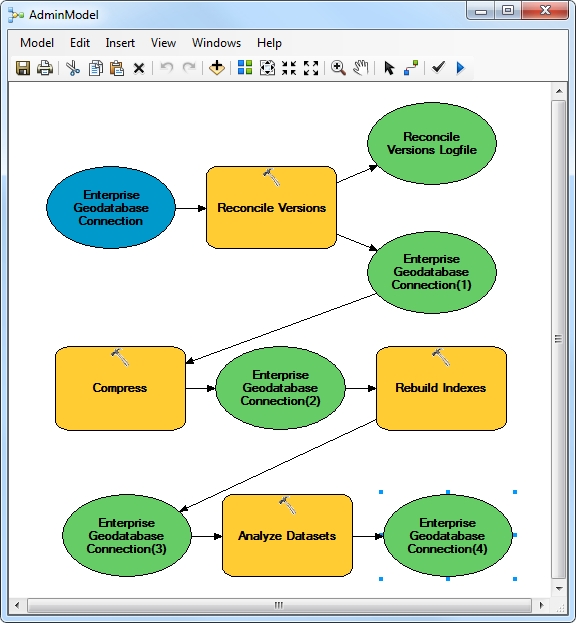To maintain good performance in a geodatabase containing versions, there are a few key administrative tasks that should be run regularly. A recommended workflow for administrators is to frequently reconcile and post, compress the geodatabase, then run the Analyze Datasets and Rebuild Indexes geoprocessing tools. This sort of routine maintenance can be set up to run nightly as a script or by building a model.
This topic discusses these administrative tools and how to make a model of this workflow. To see how you would build and run a nightly script of these tasks, see the help topic Using Python scripting to batch reconcile and post versions.
If you are unfamiliar with the tasks in this workflow or with ModelBuilder, first refer to the following help topics:
- A quick tour of reconciling a version
- The geodatabase compress operation
- Rebuild Indexes
- A quick tour of ModelBuilder
Reconcile and post
Before running the compress command, it is important to reconcile and post versions. There are several ways to run the reconciling and posting process. This topic focuses on the Reconcile Versions geoprocessing tool since this workflow includes building a model in ModelBuilder to run as a scheduled nightly task.
The reconciling and posting process merges edits between a version and any version that is the ancestor of that version, such as the parent or DEFAULT version. Child versions receive the edits made in the parent or DEFAULT version and vice versa. This process also allows ArcGIS to check for conflicts between edited versions. You can set up the Reconcile Versions geoprocessing tool to handle conflicts in favor of either the edit version or the target version representation, depending on your preference.
Compressing the geodatabase
As a geodatabase is edited over time, the adds and deletes tables increase in size. The Compress geoprocessing tool removes edits not referenced by a version and compresses edits common to all versions back to the business table, thereby increasing the performance of the geodatabase.
Rebuilding indexes
Your indexes may become fragmented after geodatabase compression. Running the Rebuild Indexes tool may therefore offer a small performance boost.
Running the Analyze Datasets tool
The Analyze Datasets geoprocessing tool is used to update statistics on datasets in the geodatabase. This tool updates the statistics of business tables, delta tables, and historical archive tables along with the statistics on the indexes associated with those tables. You should always update statistics after a compress operation.
The model
If you take all these geoprocessing tools and put them in a model in ModelBuilder, it should resemble the following:

To run this model as a nightly task, you can export it as a Python script and create a scheduled task in Windows.